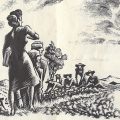Celebrate Black History Month
The Smithsonian is celebrating Black History Month, Feb. 1 to 28, with more than 40 events — films, performances, talks, tours and family programs.

On February 1, 1960, four African American college students sat down at a lunch counter at Woolworth’s in Greensboro, North Carolina, and politely asked for service. Their request was refused. When asked to leave, they remained in their seats. Their passive resistance and peaceful sit-down demand helped ignite a youth-led movement to challenge racial inequality throughout the South. (Photo courtesy of Greensboro News and Record)
This year’s feature event is a family festival at the National Museum of American History on Saturday, Feb. 27, from 10 a.m. to 5:30 p.m. The day includes performances of the award-winning interactive theatrical presentation “Join the Student Sit-Ins” (11 a.m., 2 p.m., and 4 p.m.); a musical program, “Sing for Freedom,” which explores the central role of freedom songs in the civil rights movement (1, 3, and 5 p.m.); a puppet show by Schroeder Cherry, “Can You Spell Harlem?” (1:30 p.m.); an interactive bulletin board, “Lift Your Voice,” where visitors are invited to share their thoughts on the civil rights challenges our nation still faces; and arts and crafts activities. The event is free and open to the public; no reservations are required. As appropriate, Smithsonian staff may be granted up to three hours of administrative leave to attend these events.

Taken in Harlem, N.Y., in 1965, this image shows a woman supporting the Selma, Ala., civil rights march to the state capital in Montgomery. (Photo courtesy of the Smithsonian Photography Inititative and the Center fro Folklife and Cultural Heritage.)
This is the first event in the Smithsonian Heritage Months 2010 series titled “Tapestry of Cultural Rhythms.” The event also is part of American History’s 50th-anniversary commemorations of the Greensboro sit-in. Smithsonian units participating in this Black History Month family event include the Anacostia Community Museum, The Smithsonian Associates’ Discovery Theater, the National Museum of African American History and Culture, the National Museum of American History, the Smithsonian Center for Education and Museum Studies, and the Smithsonian Heritage Months Steering Committee.
Visit www.SmithsonianEducation.org/Heritage for more information on the event and for a complete schedule of Black History Month programming.
Posted: 28 January 2010








